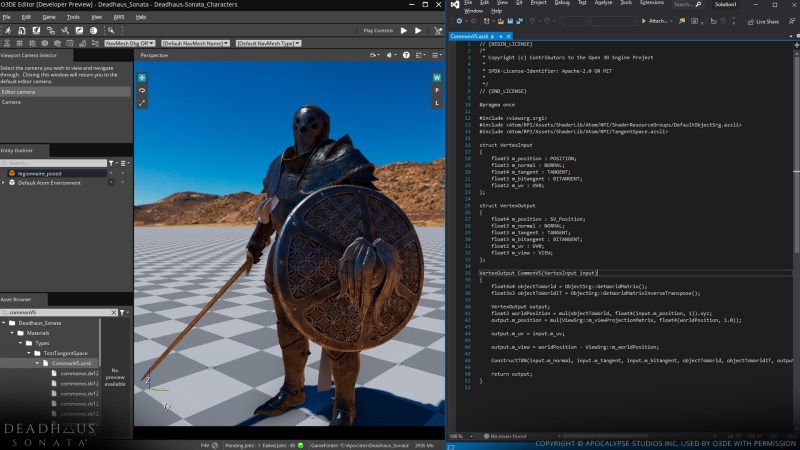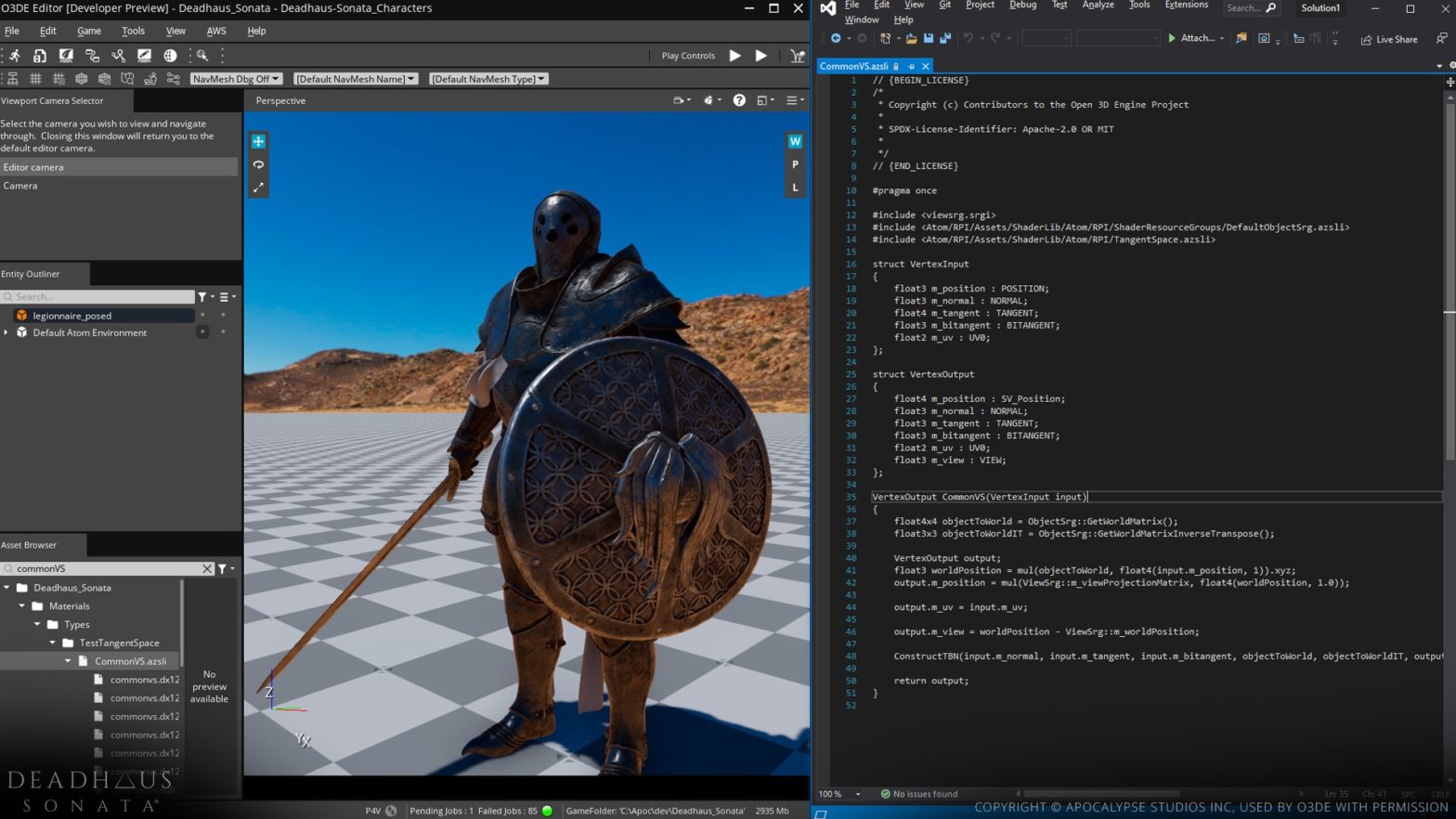
Recently Amazon revealed that they would be open sourcing the 3D engine and associated behind their Amazon Lumberyard video game tooling effort. As Lumberyard is based upon CryEngine 3.8 (~ 2015 vintage), this raises the concern of whether this brand-new open source engine – – artistically called Open 3D Engine ( O3DE ) – – is an open source variation of a CryTek engine, and what this gives those people who like to play with 2D, 3D video games and comparable.
When reviewing the marketing products, one may be forgiven for believing that O3DE is the very best thing because sliced 3D bread, and is Amazon’s kindhearted present to the unwashed masses to release them from the chains troubled them by exclusive engines like Unity and Unreal Engine. A closer appearance exposes nevertheless that O3DE is Lumberyard, however with lots of parts of Lumberyard changed , consisting of the renderer still in the procedure of being reworded from the old CryEngine code.
.What Makes a Good Game Engine?
My own video game advancement tries begun with the Half Life engine and the Valve Hammer editor , in addition to the Doom map editor. This implied that some expectations were set prior to experiencing today’s video game engines and their tools. The advancement experience with the Hammer editor in the late 1990s was practically WYSIWYG, and when I was simply starting with Unreal Engine 4 (UE4) a variety of years back this was basically the very same experience, making it reasonably simple to strike the ground running.
Installing UE4 takes a couple of actions: after setting up the Epic launcher utilizing its installer and visiting with an Epic Games account, it takes a couple of clicks to set up any of a variety of readily available variations of UE4. Later on a wizard permits the production of a brand-new video game job utilizing an optional design template. This then produces a devoted editor for the job that is likewise the video game, so you can modify it while having a live sneak peek window you can connect with.
To develop the video game, you push a single button and out rolls a video game for any of the vast array of supported target platforms. At its core, this experience permits the most important function of a great video game engine: the capability to develop video games without needing to select a battle with the engine’s tools or develop system. Numerous users are most likely to be graphics artists or comparable who have little interest in the internals of the tools which they’re utilizing.
Here the UE4 experience is fairly pain-free: utilizing the Blueprint things system you can wire up complex video games and video game reasoning in a visual editor, without any writing of code included, although C++- based advancement is possible for numerous levels of modification.
If we take this gradated system of intricacy as the gold requirement for what makes an excellent video game engine and associated tooling, how do O3DE and its main competitors (Unreal Engine, Godot and Unity) compare? In the beginning glimpse, they appear rather comparable, being all composed in C++. The most noteworthy distinction is most likely in the languages they support for extending the engine’s functions.
Here Unity supports C# for its scripting API, Godot uses GDScript (Python-like) in addition to C# and C++. Unreal Engine is extended utilizing C++, as is O3DE. All well and excellent then, however what is utilizing them like?
.The Quick Start.
Before we can set up the advancement tools on our platform of option, we require to examine the system requirements. For O3DE these are :
.Windows 10 1809 or greater, or.Ubuntu 20.04 or greater.
This contrasts with UE4’s minimum requirements of Windows 7 or greater, or MacOS 10.9 (Mavericks) or greater, both of which provide a binary installer. For Linux the engine needs to be developed from source , however ought to work with Ubuntu 16.04 LTS and up, along with a variety of other Linux circulations. For Unity the system requirements are comparable , needing Windows 7 SP1+, MacOS 10.12+ and Ubuntu 16.04+ or CentOS 7.
While Unity does not need its Unity Hub application to be utilized (up until now), it promotes it greatly as a main method to handle Unity licenses and tasks, comparable to the Epic Games Launcher application for UE4. Whether this is a concern or a property would depend mostly on one’s workflow. For handling numerous concurrent tasks with their own engine variations and keeping these upgraded, having such a main tool can be helpful.
In contrast to Unity and UE4, Godot does not declare any strong system requirements based upon the site, and must assemble on any platform that supports the needed compiler and reliances. The supplied binaries can be found in an archive, without installer and run stand-alone, making this potentially the most convenient to set up of these engines.
When setting up O3DE on Windows , it sets up the O3DE Editor and Project Manager. For Linux (the abovementioned Ubuntu 20.04 or greater), there is a DEB plan you can set up after download. From the Project Manager brand-new tasks can be produced and developed. Aside from the minimal variety of supported advancement platforms this workflow appears reasonably similar.
As there would be little point in setting up an advancement environment if it could not do the needed job, we ought to support a bit and take a look at which platforms these engines can be utilized to establish for. This ought to inform us whether we ‘d have an interest in investing our energy and time on discovering it. Here O3DE falls rather flat, a minimum of in regards to paperwork , or absence thereof.
While the Android and iOS mobile platforms are noted, discovering concrete info is hard, much like for MacOS, and just some info noted for Linux since composing. This contrasts with Godot, which notes its platforms in the function list and consists of whatever from desktop, mobile, web and console platforms, consisting of comprehensive details on how to construct for these platforms.
For Unity and UE4 we see a comparable offering of target platforms and documents to begin. O3DE would seem primarily restricted to typical desktop platforms and mobile platforms, though the paperwork is rather limited on what functions are supported. The construct guidelines for O3DE targets would recommend that it needs manual configuring of CMake and running this construct script generator prior to having the ability to construct for any target. Whether CMake is much better than Godot’s usage of SCons is another can of worms, however it does highlight the technical understanding needed for both U3DE and Godot.
.Paperwork and Support.
It’s indisputable that Unity, UE and Godot are really popular for video game advancement, with the previous 2 having strong industrial support. All of these likewise have a huge neighborhood behind them, enabled by the (fairly) open nature of these items. All of them can be utilized easily and have several years of advancement of whatever from AAA to metric loads of indie video games behind them.
The outcome of this is that even if the paperwork is uncertain on something or misses out on some information, there’s a likelihood that the neighborhood can assist with any concerns. This contrasts with the engine previously referred to as Lumberyard, which as the release notes for the most current release since composing points out is still quite in advancement which one must not anticipate to develop a production-ready item with it.
This Beta-feel continues greatly in the documents as it exists today, with none of the redundancy of the documents by the other engines. Thinking about the absence of appeal of the Amazon Lumberyard engine over the previous years, none of this is possibly all too unexpected. Regardless, these findings define what one ought to get out of diving into O3DE today.
All of which raises the concern of what the future for this job might resemble. Will it end up being a rival for Godot, Unity or – – paradises prohibited – UE4/5?
.Footing the bill.
The greatest property of items like Unity and UE is maybe that they can exist side-by-side in the divide in between AAA video games and small-time designers along with enthusiasts. The majority of this is dealt with by the licensing system of both. For UE4 this indicates complimentary to utilize and no royalties if the engine is utilized for anything besides video game advancement. There is a 5% royalty charge for any quantity over that very first million if you make a video game with UE4 that earns over $1M (USD).
For Unity, the Personal strategy is totally free, along with the Student strategy. If profits is over $100,000 in a year, the Plus strategy uses, for $399 per seat. These strategies increase with increasing earnings (next>> $ 200k/year). Like with UE4, if you do not advertise the software application, no payment is required. This contrasts with Godot, which does not have business strategies, however does get financial benefits and contributions, in addition to code contributions.
Although numerous studios have their own internal video game engine, both Unreal Engine and Unity see their items utilized in a range of business software application, all of which guarantees that even little designers and enthusiasts get to gain from bleeding edge functions carried out for these industrial clients. While Lumberyard might in theory have actually ended up being something comparable to Unity and UE4, it would appear that it didn’t get almost the very same level of financing as those 2 items do.
.Another Engine.
Despite the lofty claims about O3DE, it’s difficult to disregard the elephant in the space. After Amazon’s video game advancement aspirations got reduced a lot, its Lumberyard-based New World video game got just middling evaluations while in the background Lumberyard got de facto axed. It would therefore appear that O3DE is more of a negative method to cut the expenses of establishing a video game engine that’s apparently on its last legs.
Perhaps the very best thing to come out of this is that an existing task like Godot can take the helpful bits from O3DE engine, which would provide users the very best of both worlds: an open and completely totally free source video game engine, with good tooling and a big neighborhood supporting it. Whether this would consist of porting over the AWS Cloud Support module in O3DE is anybody’s guess.
At the end of the day, nevertheless, designer time in the OSS world is valuable. Dividing it up in between increasingly more comparable tasks would not appear to be extremely useful. Pooling resources would appear to be the best course there.
As for what works best for individuals who simply wish to make a video game, on their own or with a number of pals? UE4 or Unity if you aren’t thinking about playing with the guts of the construct system and tooling, otherwise Godot would appear to be a platform that may be good for anything from basic mobile video games to considerably more complex desktop and even console video games.
But O3DE? We’ll most likely see over the coming months or years where it winds up and whether it ends up being something capable for developing production-ready video games with. It’s not over till the last beaver sings its swansong.
[Heading image: Open 3D Engine editor with Amazon Shader Language file and property from the video game Deadhaus Sonata open. (Credit: O3DE job)]
.
Read more: hackaday.com
